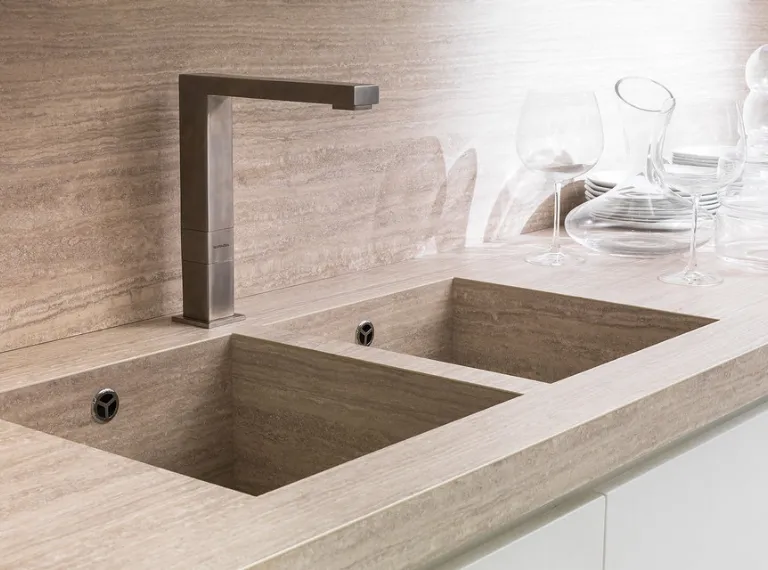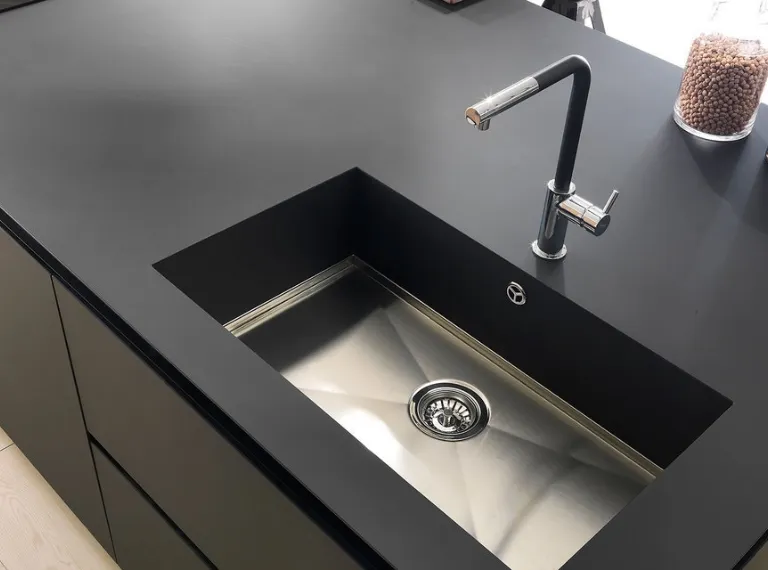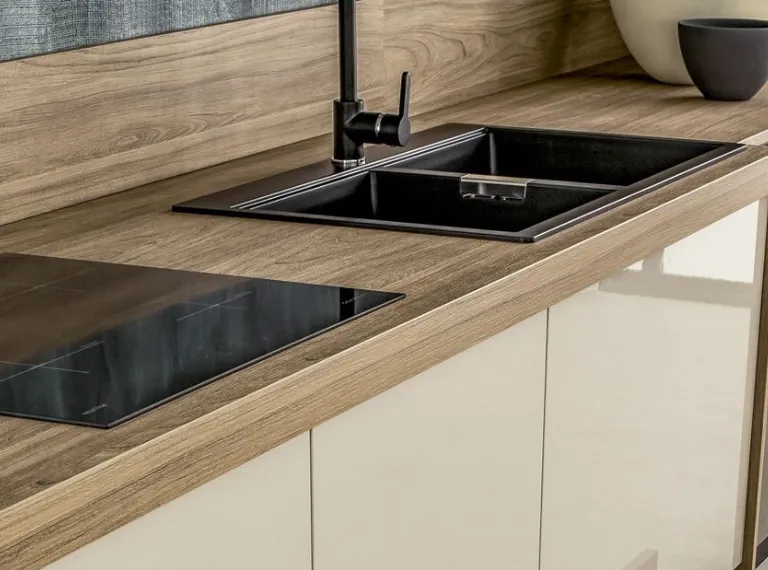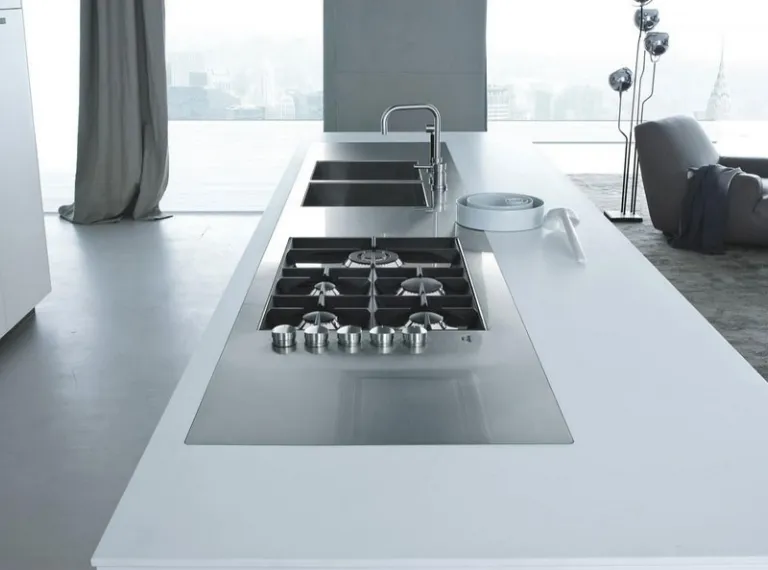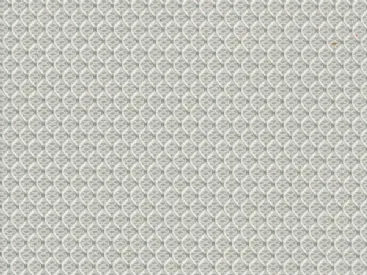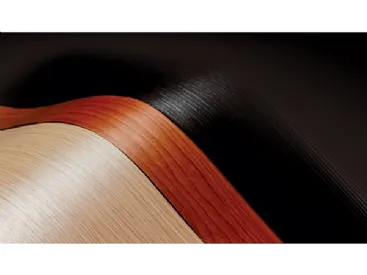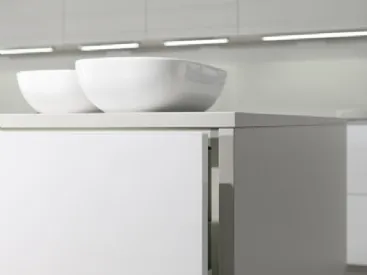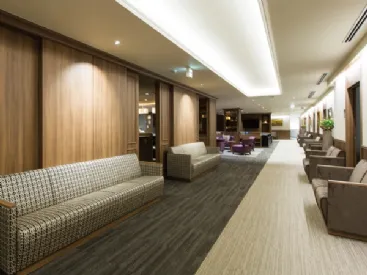Laminate kitchen worktop
The laminate è a coating material obtained from the hot coupling of più layers of paper impregnated with thermosetting resins. The types più widespread are identified by two abbreviations that indicate which production process they derive from: HPL (High Pressure Laminate) and CPL (Continuously Pressed Laminate). The first abbreviation distinguishes laminates of greater thickness and produced at high pressures. The presence on the surface of the so-called “ overlay”, a sheet of pure cellulose impregnated with melamine resin, acts as a protection of the underlying decorative layer especially against the phenomena of surface wear. The thicknesses of HPL laminates and their characteristics vary considerably in terms of color, brilliance and “ three-dimensionalityà &rdquo ;. The HPL laminate kitchen tops are characterized by a high resistance to shocks and other mechanical and chemical stresses to which the surfaces of the furniture are subjected daily. There are also self-supporting HPL laminates or “ compact”, according to the official classification; in such a case one no longer speaksù of coating material bensì of a single, homogeneous and thick top, which can be used; even exceed the centimeter. To this category of laminates belong the stratified HPL, made with layers of different colors and which can also be of other materials, for example metal sheets.
In the photo: HPL stratified laminate kitchen top
Laminate kitchen top
CPL laminates (Continuously Pressed Laminate) consist of two to four layers of impregnated paper pressed together with processes “ in continuous” in one long sheet. Qualitatively they are inferior to HPL laminates, consequently they are used less frequently for the construction of kitchen tops . The HPL laminate therefore prevails which, among other things, è characterized by an excellent quality-price ratio. The HPL laminated kitchen t ops are cheap, long lasting, antistatic as well as resistant to scratches, shocks, moisture, steam, abrasion and abrasion. spots. Normally stable to light, they are very hygienic and therefore suitable for contact with food and can be cleaned very easily: just use a simple microfibre cloth, for more dirt; obstinate is può instead any detergent. On the other hand, steel wool pads and abrasive products should be avoided. E’ It is also important to verify that the material in question is declared as Class H (Horizontal Surfaces), according to the European reference standard UNI EN 438.
In the photo: kitchen top in Fenix NTM layered laminate by Arpa Industriale Spa
Laminate kitchen top
The laminated kitchen countertop offers numerous advantages that make it increasingly ugly; also required in Italy. The defects are few, we can at least talk about possible weaknesses. First of all, especially with regard to HPL, the marked dark color (brown-reddish) of the internal layers, impregnated with phenolic resin. In particular situations, and above all in the case of very light laminates, a thin dark line may appear; be visible along the perimeter of the piece of furniture covered with laminate, creating an aesthetic effect that is sometimes not very pleasant. A ciò a reduced resistance to light is added, so it is advisable to avoid excessive exposure to sunlight otherwise the tenderà floor; to fade over time or to turn yellow. It should also be taken into account the emission of formaldehyde , remembering that the 26-rsquo; attribution of class E1 è mandatory by law.
In the photo: Arrex laminate top
Laminate kitchen countertops
Laminate kitchen top : in some cases è characterized by the so-called “ structured&rdquo finishes; or “ embossed&rdquo ;. Tali “ roughnessà ” surface can be interesting, as they manage to mask the effects of degradation deriving from the daily use of the surface of a kitchen (sometimes these finishes are in fact also proposed as scratch-resistant), however it is necessary to consider, on the other hand, the possible accumulation of dirt inside these porosities; which, among other things, threaten to alter their visual appearance, especially if the laminates have a particularly light color. Finally, let us recall another peculiarity 26-agrave; much appreciated of the laminate or its extreme versatility. Its transformism. Faithfully imitates other più materials; expensive, for example wood, concrete and natural stone.
